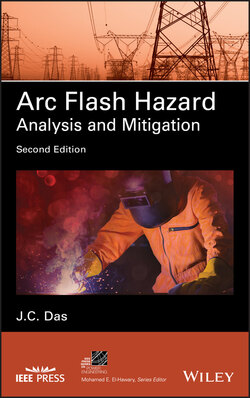Читать книгу Arc Flash Hazard Analysis and Mitigation - J. C. Das - Страница 15
1 ARC FLASH HAZARDS AND THEIR ANALYSES
ОглавлениеIn the past, industrial electrical systems in the United States have been designed considering prevalent standards, that is, ANSI/IEEE, NEC, OSHA, UL, NESC, and the like, and arc flash hazard was not a direct consideration for the electrical system designs. This environment is changing fast, and the industry is heading toward innovations in the electrical systems designs, equipment, and protection to limit the arc flash hazard, as it is detrimental to the worker safety. This opens another chapter of the power system design, analysis, and calculations hitherto not required. There is a spate of technical literature and papers on arc flash hazard, its calculation and mitigation. References [1–8] describe arcing phenomena and arc flash calculations, sometimes commenting on the methodology of arc flash hazard calculations in IEEE Guide 1584 [9] (see Chapter 3).
These issues have become of great importance in the power system planning, designs and protective relay applications. “Safety by Design” is the new frontier (see Chapter 2).
Awareness of the various hazards caused by arc flash has increased significantly over the past decade. Arc flash is a dangerous condition associated with the unexpected release of tremendous amount of energy caused by an electric arc within electrical equipment [10]. This release is in the form of intense light, heat, sound, and blast of arc products that may consist of vaporized components of enclosure material—copper, steel, or aluminum. Intense sound and pressure waves also emanate from the arc flash, which resembles a confined explosion. Arcing occurs when the insulation between the live conductors breaks down, due to aging, surface tracking, treeing phenomena, and due to human error when maintaining electrical equipment in the energized state. The insulation systems are not perfectly homogeneous and voids form due to thermal cycling. In nonself restoring insulations, treeing phenomena starts with a discharge in a cavity, which enlarges over a period of time, and the discharge patterns resemble tree branches, hence the name “treeing” (Figure 1.1). As the treeing progresses, discharge activity increases, and, ultimately the insulation resistance may be sufficiently weakened and breakdown occurs under electrical stress. Treeing phenomena is of particular importance in XLPE (cross-linked polyethylene) and nonself restoring insulations. Surface tracking occurs due to abrasion, irregularities, contamination, and moisture, which may lead to an arc formation between the line and ground. An example will be a contaminated insulator under humid conditions. Though online monitoring and partial discharge measurements are being applied as diagnostic tools, the randomness associated with a fault and insulation breakdown are well recognized, and a breakdown can occur at any time, jeopardizing the safety of a worker, who may be in close proximity of the energized equipment. Arc temperatures are of the order of 35,000°F, about four times the temperature on the surface of the sun. An arc flash can therefore cause serious fatal burns.
Figure 1.1. Treeing phenomena in nonself-restoring insulation, leading to ultimate breakdown of insulation.
